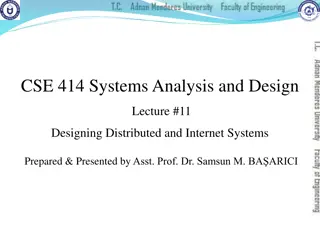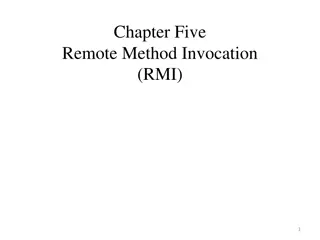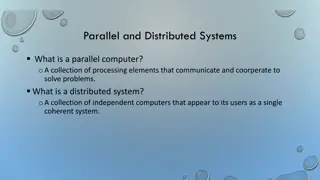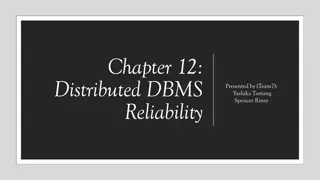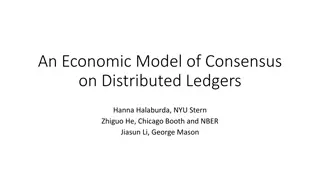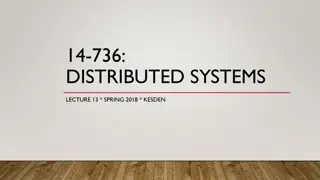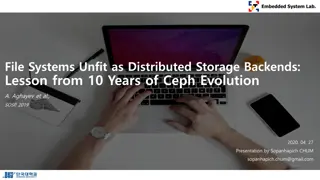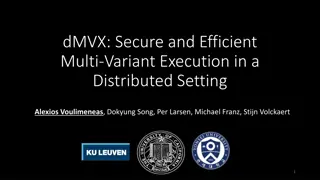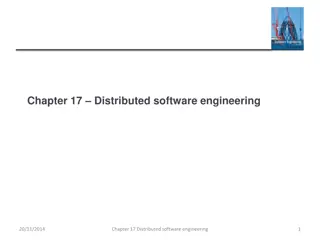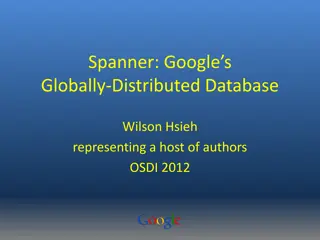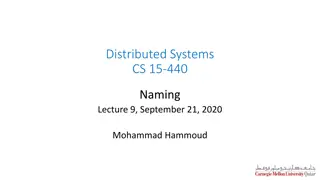
Distributed Systems: Types, Examples, and Characteristics
Explore the world of distributed systems through this comprehensive guide covering the definition, types, examples, common characteristics, advantages, and disadvantages. Learn about distributed computing systems, information systems, and pervasive systems with real-life examples such as LAN, databases, ATMs, and more. Delve into the design issues, advantages, and disadvantages of distributed systems to gain a deeper understanding of this integral technology.
Download Presentation

Please find below an Image/Link to download the presentation.
The content on the website is provided AS IS for your information and personal use only. It may not be sold, licensed, or shared on other websites without obtaining consent from the author. If you encounter any issues during the download, it is possible that the publisher has removed the file from their server.
You are allowed to download the files provided on this website for personal or commercial use, subject to the condition that they are used lawfully. All files are the property of their respective owners.
The content on the website is provided AS IS for your information and personal use only. It may not be sold, licensed, or shared on other websites without obtaining consent from the author.
E N D
Presentation Transcript
www.studymafia.org Seminar On Distributed Systems Submitted To: www.studymafia.org www.studymafia.org Submitted By:
CONTENT What is a Distributed System Types of Distributed Systems Examples of Distributed Systems Common Characteristics Basic Design Issues Advantages Disadvantages Conclusion 2
1. WHATISA DISTRIBUTED SYSTEM? Definition: A distributed system is one in which components located at networked computers communicate and coordinate their actions only by passing messages. This definition leads to the following characteristics of distributed systems: Concurrency of components Lack of a global clock Independent failures of components 3
2. TYPESOFDISTRIBUTEDSYSTEMS Distributed Computing Systems. Distributed Information Systems. Distributed Pervasive Systems. Distributed Computing Systems: The distributed computing systems include the following: Cluster computing systems Grid computing systems 4
Distributed Informative Systems: In the distributed systems, the following forms are concentrated: Transaction processing systems Enterprise application integration Distributed Pervasive Systems: Few examples of distributed pervasive systems are as below: Home systems Electronic health care systems Sensor networks 5
3. EXAMPLESOF DISTRIBUTED SYSTEMS Local Area Network and Intranet Database Management System Automatic Teller Machine Network Internet/World-Wide Web Mobile and Ubiquitous Computing 6
3.1 LOCAL AREA NETWORK Desktop computers email server print and other servers Local area network Web server email server print File server other servers the rest of the Internet router/firewall 7
3.4 INTERNET intranet ISP backbone satellite link desktop computer: server: network link: 10
3.4.2 WEB SERVERSAND WEB BROWSERS http://www.google.comlsearch?q=lyu www.google.com Browsers Web servers Internet www.uu.se http://www.uu.se/ www.w3c.org http://www.w3c.org/Protocols/Activity.html File system of www.w3c.org Protocols Activity.html 12
3.5 MOBILEAND UBIQUITOUS COMPUTING Internet GSM/GPRS gateway Host intranet Home intranet Wireless LAN Mobile phone Printer Laptop Host site Camera 13
4. COMMON CHARACTERISTICS What are we trying to achieve when we construct a distributed system? Certain common characteristics can be used to assess distributed systems Heterogeneity Openness Security Scalability Failure Handling Concurrency Transparency 14
4.1 HETEROGENEITY Variety and differences in Networks Computer hardware Operating systems Programming languages Implementations by different developers Middleware as software layers to provide a programming abstraction as well as masking the heterogeneity of the underlying networks, hardware, OS, and programming languages (e.g., CORBA). Mobile Code to refer to code that can be sent from one computer to another and run at the destination (e.g., Java applets and Java virtual machine). 15
4.2 OPENNESS Openness is concerned with extensions and improvements of distributed systems. Detailed interfaces of components need to be published. New components have to be integrated with existing components. Differences in data representation of interface types on different processors (of different vendors) have to be resolved. 16
4.3 SECURITY In a distributed system, clients send requests to access data managed by servers, resources in the networks: Doctors requesting records from hospitals Users purchase products through electronic commerce Security is required for: Concealing the contents of messages: security and privacy Identifying a remote user or other agent correctly (authentication) New challenges: Denial of service attack Security of mobile code 17
4.4 SCALABILITY Adaptation of distributed systems to accommodate more users respond faster (this is the hard one) Usually done by adding more and/or faster processors. Components should not need to be changed when scale of a system increases. Design components to be scalable! 18
4.5 FAILURE HANDLING (FAULT TOLERANCE) Hardware, software and networks fail! Distributed systems must maintain availability even at low levels of hardware/software/network reliability. Fault tolerance is achieved by recovery redundancy 19
4.6 CONCURRENCY Components in distributed systems are executed in concurrent processes. Components access and update shared resources (e.g. variables, databases, device drivers). Integrity of the system may be violated if concurrent updates are not coordinated. Lost updates Inconsistent analysis 20
4.7 TRANSPARENCY Distributed systems should be perceived by users and application programmers as a whole rather than as a collection of cooperating components. Transparency has different aspects. These represent various properties that distributed systems should have. 21
5. BASIC DESIGN ISSUES General software engineering principles include rigor and formality, separation of concerns, modularity, abstraction, anticipation of change, Specific issues for distributed systems: Naming Communication Software structure System architecture Workload allocation Consistency maintenance 30
5.1 NAMING A name is resolved when translated into an interpretable form for resource/object reference. Communication identifier (IP address + port number) Name resolution involves several translation steps Design considerations Choice of name space for each resource type Name service to resolve resource names to comm. id. Name services include naming context resolution, hierarchical structure, resource protection 31
5.2 COMMUNICATION Separated components communicate with sending processes and receiving processes for data transfer and synchronization. Message passing: send and receive primitives synchronous or blocking asynchronous or non-blocking Abstractions defined: channels, sockets, ports. Communication patterns: client-server communication (e.g., RPC, function shipping) and group multicast 32
5.3 SOFTWARE STRUCTURE Layers in centralized computer systems: Applications Middleware Operating system Computer and Network Hardware 33
5.3 SOFTWARE STRUCTURE Layers and dependencies in distributed systems: Applications Open services Distributed programming support Open system kernel services Computer and network hardware 34
5.4 SYSTEM ARCHITECTURES Client-Server Peer-to-Peer Services provided by multiple servers Proxy servers and caches Mobile code and mobile agents Network computers Thin clients and mobile devices 35
5.4.1 CLIENTS INVOKE INDIVIDUAL SERVERS Client Server invocation invocation result result Server Client Key: Process: Computer: 36
5.4.2 PEER-TO-PEER SYSTEMS Peer 2 Peer 1 Application Application Peer 3 Sharable objects Application Peer 4 Application Peers 5 .... N 37
5.4.3 A SERVICEBY MULTIPLE SERVERS Service Server Client Server Client Server 38
5.4.4 WEB PROXY SERVER Web server Client Proxy server Web server Client 39
5.4.5 WEB APPLETS a) client request results in the downloading of applet code Web server Client Applet code b) client interacts with the applet Web server Client Applet 40
5.4.6 THIN CLIENTSAND COMPUTE SERVERS Compute server Network computer or PC Application Process network Thin Client 41
6.ADVANTAGES Sharing Data : There is a provision in the environment where user at one site may be able to access the data residing at other sites. Autonomy : Because of sharing data by means of data distribution each site is able to retain a degree of control over data that are stored locally. Availability : If one site fails in a distributed system, the remaining sites may be able to continue operating. Thus a failure of a site doesn't necessarily imply the shutdown of the System. 42
7. DISADVANTAGES Software Development Cost Greater Potential for Bugs increased Processing Overhead 43
REFERENCES www.google.com www.wikipedia.com www.studymafia.org



